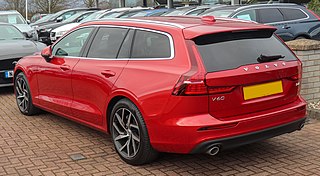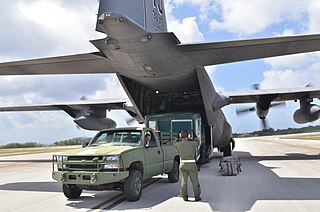See also
- Chevrolet Suburban – offered as a "Carryall Suburban"
- Project Carryall, a Project Plowshare program to excavate for a highway in California with nuclear explosives
The term carryall refers to several types of vehicles, including: historical carriages, automobiles, sleighs, and tractors.
Historically, a carryall was a type of carriage used in the United States in the 19th century. It is a light, four-wheeled vehicle, usually drawn by a single horse and with seats for four or more passengers. [1] The word is derived by folk etymology from the French cariole . [2]
The name carryall was later used for a panel truck with rear windows and folding rear seats, allowing for the transport of either passengers, cargo, or both. [3] This sort of vehicle is an ancestor of today's sport utility vehicles. These vehicles were often converted by smaller coachbuilders as sales numbers were generally too small to justify tooling for series production. The Chevrolet Suburban SUV was once known as the Carryall Suburban.
In Canada, the term "carryall" is often also used to refer to a type of sleigh. It is about 4 m (13 ft) long and 0.5 m (1.5 ft) wide, fitted with a canvas or hide container. It is pulled by dogs or a snowmobile. It is used principally by trappers and hunters to transport people and goods. [4]
The term is also used for a carrier with a scraper-like self-loading device drawn by a tractor, pushed by a bulldozer or self-propelled. It is used especially for hauling earth and crushed rock.[ citation needed ] Similarly in agricultural parlance it is often used to describe a platform device mounted to the rear three point linkage of smaller tractors for carrying materials particularly tools or stock feed. [ citation needed ]

A sport utility vehicle (SUV) is a car classification that combines elements of road-going passenger cars with features from off-road vehicles, such as raised ground clearance and four-wheel drive.

A pickup truck or pickup is a light-duty truck that has an enclosed cabin, and a back end made up of a cargo bed that is enclosed by three low walls with no roof. In Australia and New Zealand, both pickups and coupé utilities are called utes, short for utility vehicle. In South Africa, people of all language groups use the term bakkie; a diminutive of Afrikaans: bak, meaning bowl or container.

A van is a type of road vehicle used for transporting goods or people. Depending on the type of van, it can be bigger or smaller than a pickup truck and SUV, and bigger than a common car. There is some variation in the scope of the word across the different English-speaking countries. The smallest vans, microvans, are used for transporting either goods or people in tiny quantities. Mini MPVs, compact MPVs, and MPVs are all small vans usually used for transporting people in small quantities. Larger vans with passenger seats are used for institutional purposes, such as transporting students. Larger vans with only front seats are often used for business purposes, to carry goods and equipment. Specially equipped vans are used by television stations as mobile studios. Postal services and courier companies use large step vans to deliver packages.

A sled, skid, sledge, or sleigh is a land vehicle that slides across a surface, usually of ice or snow. It is built with either a smooth underside or a separate body supported by two or more smooth, relatively narrow, longitudinal runners similar in principle to skis. This reduces the amount of friction, which helps to carry heavy loads.

A station wagon or estate car, is an automotive body-style variant of a sedan with its roof extended rearward over a shared passenger/cargo volume with access at the back via a third or fifth door, instead of a trunk/boot lid. The body style transforms a standard three-box design into a two-box design—to include an A, B, and C-pillar, as well as a D-pillar. Station wagons can flexibly reconfigure their interior volume via fold-down rear seats to prioritize either passenger or cargo volume.

A cart or dray is a vehicle designed for transport, using two wheels and normally pulled by draught animals such as horses, donkeys, mules and oxen, or even smaller animals such as goats or large dogs.

A coupe or coupé is a passenger car with a sloping or truncated rear roofline and two doors.

A carriage is a private four-wheeled vehicle for people and is most commonly horse-drawn. Second-hand private carriages were common public transport, the equivalent of modern cars used as taxis. Carriage suspensions are by leather strapping or, on those made in recent centuries, steel springs. Two-wheeled carriages are informal and usually owner-driven.

Coupé de ville — also known as town car or sedanca de ville — is a car body style produced from 1908 to 1939 with an external or open-topped driver's position and an enclosed compartment for passengers. Although the different terms may have once had specific meanings for certain car manufacturers or countries, the terms are often used interchangeably.
There are many types of car body styles. They vary depending on intended use, market position, location, and the era they were made.

The Chevrolet Suburban is a series of automobiles built by the Chevrolet division of General Motors. In production since the 1935 model year, the model line is currently in its twelfth generation; it is the longest-used automobile nameplate in the world. Beginning life as one of the first metal-bodied station wagons, the Suburban is the progenitor of modern full-size SUVs, combining a station wagon body with the chassis and powertrain of a pickup truck. Alongside its Advance Design, Task Force, and C/K predecessors, the Silverado pickup trucks share chassis and mechanical commonality with the Suburban.

A panel truck in U.S. and Canadian usage is a small delivery truck with a fully enclosed body. It typically is high and has no rear windows in the rear cargo area. The term was first used in the early 1910s. Panel trucks were marketed for contracting, deliveries, and other businesses. Often described as a small van used mostly for delivery rounds, the British equivalent is a "delivery van."

The trunk or boot of a car is the vehicle's main storage or cargo compartment, often a hatch at the rear of the vehicle. It can also be called a tailgate.

A horse-drawn vehicle is a piece of equipment pulled by one or more horses. These vehicles typically have two or four wheels and were used to carry passengers or a load. They were once common worldwide, but they have mostly been replaced by automobiles and other forms of self-propelled transport but are still in use today.

The Commercial Utility Cargo Vehicle (CUCV) is a vehicle program instituted to provide the United States military with light utility vehicles based on civilian trucks.

In aviation, a jump seat or jumpseat is an auxiliary seat for individuals—other than normal passengers—who are not operating the aircraft. In general, the term 'jump seat' can also refer to a seat in any type of vehicle which can fold up out of the way; vehicles include carriages, automobiles, vans, buses, fire tenders, and taxicabs. The term originated in the United States c. 1860 for a movable carriage seat.

The Chevrolet Task Force is a light and medium-duty truck series by Chevrolet, their first major redesign since 1947. Its GMC counterpart was the Blue Chip series. It was billed as being more stylish compared to the earlier Advance Design Series while still maintaining its rugged durability. First available on March 25, 1955, these trucks were sold with various minor changes over the years until 1959, when the C/K Series trucks replaced the Task Force models for 1960.

The Dodge Town Panel and Dodge Town Wagon are respectively a panel truck and a carryall, manufactured between 1954 and 1966 in the U.S. and between 1954 and 1971 in Argentina by Dodge. The Town Panel and Town Wagon trucks were based upon the design of the Dodge C series pickup trucks with round fenders and wraparound windshields. Even after the Dodge D series "Sweptline" pickup trucks with square fenders and flat windshields were released, the Town Wagons retained the 1958 sheet metal design of the C series pickups and heavy-duty trucks. They were produced until 1966, when the Dodge A100 commercial and passenger vans eliminated the need for the pickup chassis version. A passenger sport utility version of the Dodge D series truck was not again developed until the third-generation D series–based Dodge Ramcharger, a competitor to the Chevrolet Blazer.

The second generation of the C/K series is a range of trucks that was manufactured by General Motors. Marketed by both the Chevrolet and GMC divisions from the 1967 to 1972 model years, this generation was given the "Action Line" moniker by General Motors. As with its predecessor, the second generation C/K included full-size pickup trucks, chassis cab trucks, and medium-duty commercial trucks.

The Bedford HC is a small commercial vehicle that was made by Bedford, beginning in 1938. The vehicle shared its running gear with the H-series Vauxhall 10-4 saloon. Production of civilian vehicles ceased during World War II with the HC van re-entering production for a little while following hostilities. The HC was later joined by the heavier duty Bedford JC, which was itself replaced by the higher-roofed Bedford PC after the war. With the arrival of the much more modern Bedford CA the by now outmoded PC was finally retired.
A truck with a panel type body having windows and folding and/or removable seats designed to transport supplies and/or equipment and personnel